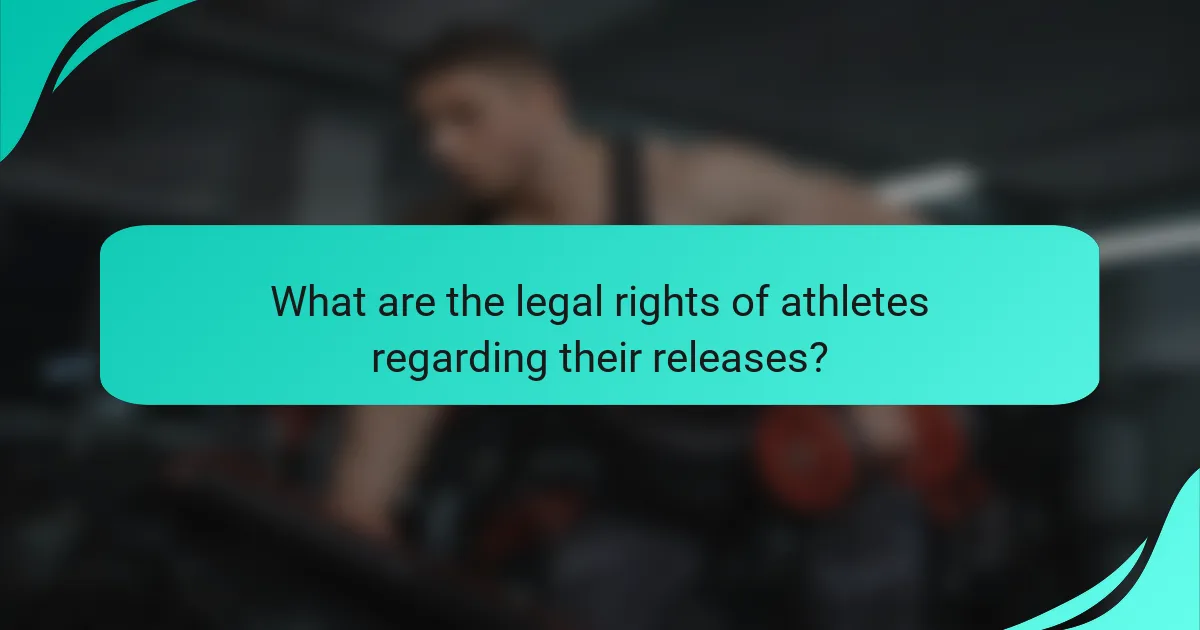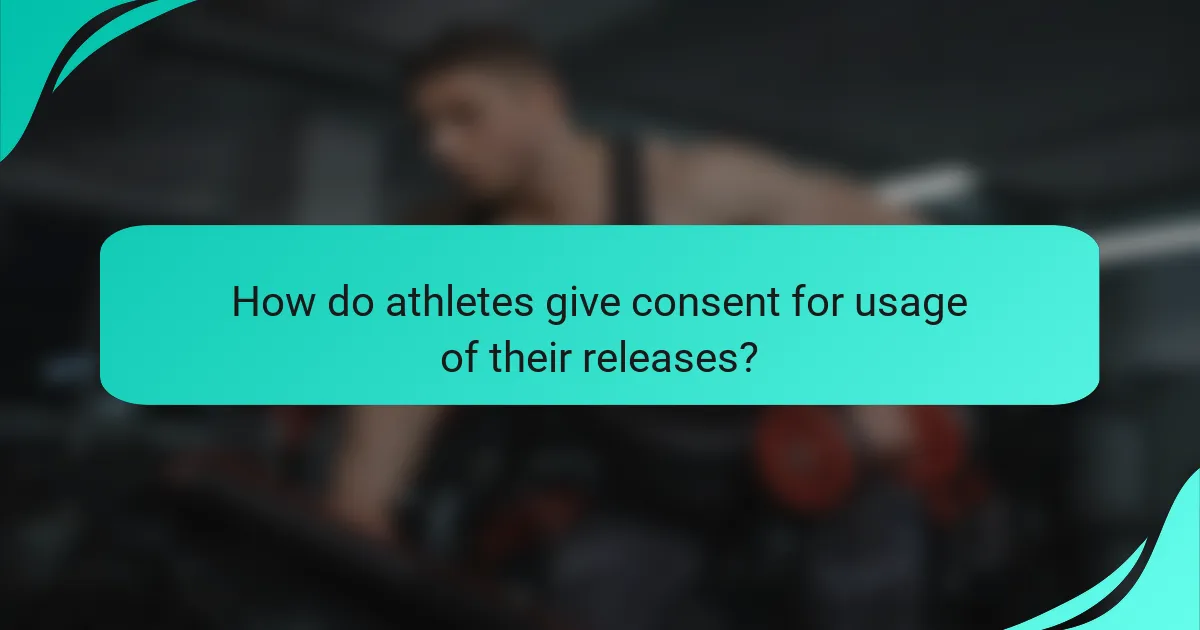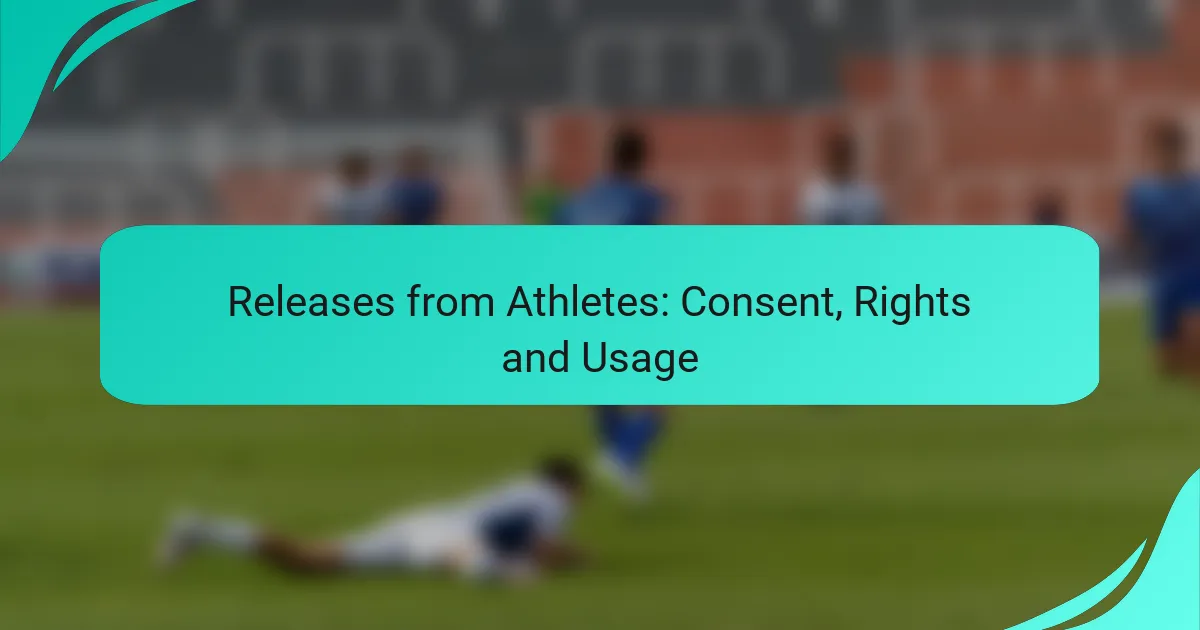Athletes possess distinct legal rights regarding their releases, encompassing intellectual property, privacy, and contractual obligations. These rights are essential for controlling the use of their images, names, and performances, thereby safeguarding their personal brand. Consent for such usage is typically granted through formal agreements, highlighting the importance of understanding these processes for both athletes and organizations. Unauthorized use can result in serious legal and reputational consequences, making it vital to adhere to ethical standards and protect these rights.

What are the legal rights of athletes regarding their releases?
Athletes have specific legal rights concerning their releases, which include intellectual property rights, privacy rights, and contractual obligations. These rights dictate how their images, names, and performances can be used, ensuring they maintain control over their personal brand and likeness.
Intellectual property rights
Athletes typically hold intellectual property rights over their names, images, and likenesses. This means they can control how these elements are used commercially, such as in advertising or merchandise. Unauthorized use can lead to legal action, so athletes should be aware of their rights and how to protect them.
For example, an athlete may license their image for promotional materials, receiving compensation in return. It’s crucial for athletes to understand the terms of any release they sign, as these can affect their ability to monetize their likeness in the future.
Privacy rights
Privacy rights protect athletes from unauthorized public exposure and exploitation of their personal lives. This includes safeguarding against the use of their image or personal information without consent. Athletes should be vigilant about how their privacy rights are defined in any release agreements.
For instance, if an athlete’s personal story is shared in a documentary, they should ensure they have given explicit permission for its use. Understanding the extent of privacy rights can help athletes maintain control over their personal narrative and public perception.
Contractual obligations
Athletes often enter into contracts that outline their obligations regarding the use of their likeness and performance. These contracts can specify how and when their image can be used, as well as any compensation involved. It’s essential for athletes to carefully review these contracts before signing.
Common pitfalls include signing away rights without fully understanding the implications. Athletes should seek legal advice to ensure they are not inadvertently limiting their future opportunities or compromising their rights in any release agreements.

How do athletes give consent for usage of their releases?
Athletes typically give consent for the usage of their releases through formal agreements, which can be either written or verbal. Understanding the nuances of these consent methods is crucial for both athletes and organizations to ensure proper rights management and usage compliance.
Written consent forms
Written consent forms are the most reliable method for athletes to grant permission for the use of their releases. These documents clearly outline the scope of usage, duration, and any compensation involved, providing legal protection for both parties. Athletes should ensure they read and understand all terms before signing.
Common elements in written consent forms include the specific media types (e.g., print, digital), geographic limitations, and the duration of the consent. For example, a form might specify that an athlete’s image can be used in promotional materials for a particular event for one year.
Verbal agreements
Verbal agreements can also serve as a means of consent, but they carry more risk due to the lack of documentation. While they may be quicker to establish, they can lead to misunderstandings regarding the terms of usage. Athletes should be cautious and consider following up verbal agreements with written confirmation.
To minimize potential disputes, athletes should clarify the details of any verbal consent, including what is being agreed upon and for how long. It’s advisable to document these conversations in writing afterward, such as through an email summary, to create a record of the agreement.

What are the implications of unauthorized usage of athlete releases?
Unauthorized usage of athlete releases can lead to significant legal and reputational repercussions for both the athlete and the entity using the content. Understanding these implications is crucial for maintaining ethical standards and protecting rights.
Legal consequences
Using an athlete’s image, likeness, or personal story without permission can result in legal action, including lawsuits for copyright infringement or violation of publicity rights. Athletes have the right to control how their identity is used commercially, and unauthorized usage can lead to costly settlements or judgments.
In many jurisdictions, athletes can seek damages that may include lost profits, statutory damages, and attorney fees. It’s essential for organizations to obtain clear, written consent through athlete release forms to avoid these legal pitfalls.
Reputational damage
Unauthorized usage can severely harm the reputation of both the athlete and the organization involved. Athletes may feel exploited or disrespected, leading to public backlash and a loss of fan trust. This can result in decreased marketability and sponsorship opportunities.
Organizations that misuse athlete releases risk damaging their brand image, which can deter future partnerships and collaborations. Maintaining ethical practices in athlete representation is vital for long-term success and credibility in the sports industry.

How can brands ethically use athlete releases?
Brands can ethically use athlete releases by ensuring transparency and obtaining informed consent from the athletes involved. This involves clear communication about how the athlete’s image, name, and likeness will be utilized in marketing and promotional materials.
Clear communication of intent
Brands must clearly communicate their intent when seeking athlete releases. This includes specifying the purpose of the release, the platforms where the content will appear, and the duration of usage. Providing this information helps athletes make informed decisions about their participation.
For example, if a brand intends to use an athlete’s image in social media campaigns, they should outline which platforms will be used, such as Instagram or Facebook, and for how long the content will be active. This transparency builds trust and fosters a positive relationship between the athlete and the brand.
Respecting athlete privacy
Respecting athlete privacy is crucial when utilizing their releases. Brands should avoid using personal information or images in ways that could be deemed invasive or inappropriate. This includes not sharing sensitive details about the athlete’s life without explicit permission.
Additionally, brands should consider the context in which they are using the athlete’s likeness. For instance, using an athlete’s image in a campaign that contradicts their values or public persona can lead to backlash and damage both the athlete’s and the brand’s reputation. Always prioritize the athlete’s comfort and boundaries in all marketing efforts.

What frameworks exist for athlete release agreements?
Athlete release agreements are structured frameworks that outline the terms under which athletes grant permission for the use of their likeness, name, or performance. These agreements typically ensure that both the athlete’s rights and the interests of the organizations utilizing their image are protected.
Standardized contracts
Standardized contracts serve as templates for athlete release agreements, providing a consistent foundation for negotiations. These contracts often include essential elements such as the scope of usage, duration, compensation, and termination clauses. Utilizing a standardized contract can streamline the process and reduce legal complexities.
Common examples of standardized contracts include those used by professional sports leagues, which often have established guidelines for player endorsements and media appearances. Familiarity with these templates can help athletes and their representatives navigate the negotiation process more effectively.
Negotiation best practices
Effective negotiation of athlete release agreements requires clear communication and understanding of both parties’ needs. Athletes should prioritize their rights and ensure that the terms reflect fair compensation for the use of their image or performance. It’s advisable to consult with legal professionals who specialize in sports law to avoid common pitfalls.
Key best practices include defining the scope of usage explicitly, discussing potential future uses, and considering the duration of the agreement. Athletes should also be cautious about exclusivity clauses that may limit their opportunities with other brands or organizations.

What are the emerging trends in athlete release management?
Emerging trends in athlete release management focus on enhancing consent processes and empowering athletes regarding their rights and usage of personal data. These trends are reshaping how organizations interact with athletes and manage their releases, ensuring greater transparency and control for the athletes.
Digital consent technologies
Digital consent technologies streamline the process of obtaining and managing athlete releases. These tools allow athletes to provide consent electronically, often through secure platforms that track and store agreements. This shift reduces paperwork and enhances accessibility for both athletes and organizations.
Examples of digital consent technologies include mobile apps and online portals that facilitate real-time updates and notifications. By using these systems, organizations can ensure that consent is current and easily retrievable, which is crucial for compliance with regulations like GDPR in Europe.
Increased athlete advocacy
Increased athlete advocacy is leading to a stronger emphasis on the rights of athletes regarding their personal data and image usage. Athletes are becoming more vocal about their expectations for transparency and fair compensation when their likenesses are used in various media.
Organizations are responding by developing clearer policies and guidelines that prioritize athlete input. This advocacy can manifest in collective bargaining agreements or individual negotiations, ensuring that athletes have a say in how their releases are managed and utilized.
